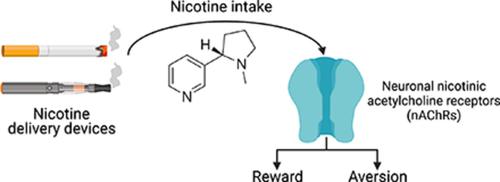当前位置:
X-MOL 学术
›
Pharmacol. Rev.
›
论文详情
Our official English website, www.x-mol.net, welcomes your
feedback! (Note: you will need to create a separate account there.)
Neurobiological Mechanisms of Nicotine Reward and Aversion
Pharmacological Reviews ( IF 19.3 ) Pub Date : 2022-01-01 , DOI: 10.1124/pharmrev.121.000299 Lauren Wills 1 , Jessica L Ables 1 , Kevin M Braunscheidel 1 , Stephanie P B Caligiuri 1 , Karim S Elayouby 1 , Clementine Fillinger 1 , Masago Ishikawa 1 , Janna K Moen 1 , Paul J Kenny 2
Pharmacological Reviews ( IF 19.3 ) Pub Date : 2022-01-01 , DOI: 10.1124/pharmrev.121.000299 Lauren Wills 1 , Jessica L Ables 1 , Kevin M Braunscheidel 1 , Stephanie P B Caligiuri 1 , Karim S Elayouby 1 , Clementine Fillinger 1 , Masago Ishikawa 1 , Janna K Moen 1 , Paul J Kenny 2
Affiliation

|
Neuronal nicotinic acetylcholine receptors (nAChRs) regulate the rewarding actions of nicotine contained in tobacco that establish and maintain the smoking habit. nAChRs also regulate the aversive properties of nicotine, sensitivity to which decreases tobacco use and protects against tobacco use disorder. These opposing behavioral actions of nicotine reflect nAChR expression in brain reward and aversion circuits. nAChRs containing α4 and β2 subunits are responsible for the high-affinity nicotine binding sites in the brain and are densely expressed by reward-relevant neurons, most notably dopaminergic, GABAergic, and glutamatergic neurons in the ventral tegmental area. High-affinity nAChRs can incorporate additional subunits, including β3, α6, or α5 subunits, with the resulting nAChR subtypes playing discrete and dissociable roles in the stimulatory actions of nicotine on brain dopamine transmission. nAChRs in brain dopamine circuits also participate in aversive reactions to nicotine and the negative affective state experienced during nicotine withdrawal. nAChRs containing α3 and β4 subunits are responsible for the low-affinity nicotine binding sites in the brain and are enriched in brain sites involved in aversion, including the medial habenula, interpeduncular nucleus, and nucleus of the solitary tract, brain sites in which α5 nAChR subunits are also expressed. These aversion-related brain sites regulate nicotine avoidance behaviors, and genetic variation that modifies the function of nAChRs in these sites increases vulnerability to tobacco dependence and smoking-related diseases. Here, we review the molecular, cellular, and circuit-level mechanisms through which nicotine elicits reward and aversion and the adaptations in these processes that drive the development of nicotine dependence.
中文翻译:

尼古丁奖赏和厌恶的神经生物学机制
神经元烟碱乙酰胆碱受体(nAChR)调节烟草中尼古丁的奖励作用,从而建立和维持吸烟习惯。 nAChR 还调节尼古丁的厌恶特性,对尼古丁的敏感性可减少烟草使用并防止烟草使用障碍。尼古丁的这些相反的行为反映了大脑奖赏和厌恶回路中 nAChR 的表达。含有α 4 和β 2 亚基的 nAChR 负责大脑中高亲和力尼古丁结合位点,并由奖励相关神经元密集表达,最显着的是腹侧被盖区的多巴胺能、GABA 能和谷氨酸能神经元。高亲和力 nAChR 可以整合其他亚基,包括β 3、 α 6 或α 5 亚基,由此产生的 nAChR 亚型在尼古丁对大脑多巴胺传输的刺激作用中发挥离散和可分离的作用。大脑多巴胺回路中的 nAChR 也参与对尼古丁的厌恶反应以及尼古丁戒断期间经历的负面情感状态。含有α 3 和β 4 亚基的 nAChR 负责大脑中低亲和力尼古丁结合位点,并且在涉及厌恶的大脑部位富集,包括内侧缰核、脚间核和孤束核,这些部位α 5 nAChR 亚基也被表达。这些与厌恶相关的大脑位点调节尼古丁回避行为,而改变这些位点中 nAChR 功能的遗传变异会增加对烟草依赖和吸烟相关疾病的脆弱性。 在这里,我们回顾了尼古丁引起奖赏和厌恶的分子、细胞和回路水平机制,以及这些过程中推动尼古丁依赖发展的适应。
更新日期:2022-01-11
中文翻译:

尼古丁奖赏和厌恶的神经生物学机制
神经元烟碱乙酰胆碱受体(nAChR)调节烟草中尼古丁的奖励作用,从而建立和维持吸烟习惯。 nAChR 还调节尼古丁的厌恶特性,对尼古丁的敏感性可减少烟草使用并防止烟草使用障碍。尼古丁的这些相反的行为反映了大脑奖赏和厌恶回路中 nAChR 的表达。含有α 4 和β 2 亚基的 nAChR 负责大脑中高亲和力尼古丁结合位点,并由奖励相关神经元密集表达,最显着的是腹侧被盖区的多巴胺能、GABA 能和谷氨酸能神经元。高亲和力 nAChR 可以整合其他亚基,包括β 3、 α 6 或α 5 亚基,由此产生的 nAChR 亚型在尼古丁对大脑多巴胺传输的刺激作用中发挥离散和可分离的作用。大脑多巴胺回路中的 nAChR 也参与对尼古丁的厌恶反应以及尼古丁戒断期间经历的负面情感状态。含有α 3 和β 4 亚基的 nAChR 负责大脑中低亲和力尼古丁结合位点,并且在涉及厌恶的大脑部位富集,包括内侧缰核、脚间核和孤束核,这些部位α 5 nAChR 亚基也被表达。这些与厌恶相关的大脑位点调节尼古丁回避行为,而改变这些位点中 nAChR 功能的遗传变异会增加对烟草依赖和吸烟相关疾病的脆弱性。 在这里,我们回顾了尼古丁引起奖赏和厌恶的分子、细胞和回路水平机制,以及这些过程中推动尼古丁依赖发展的适应。











































 京公网安备 11010802027423号
京公网安备 11010802027423号